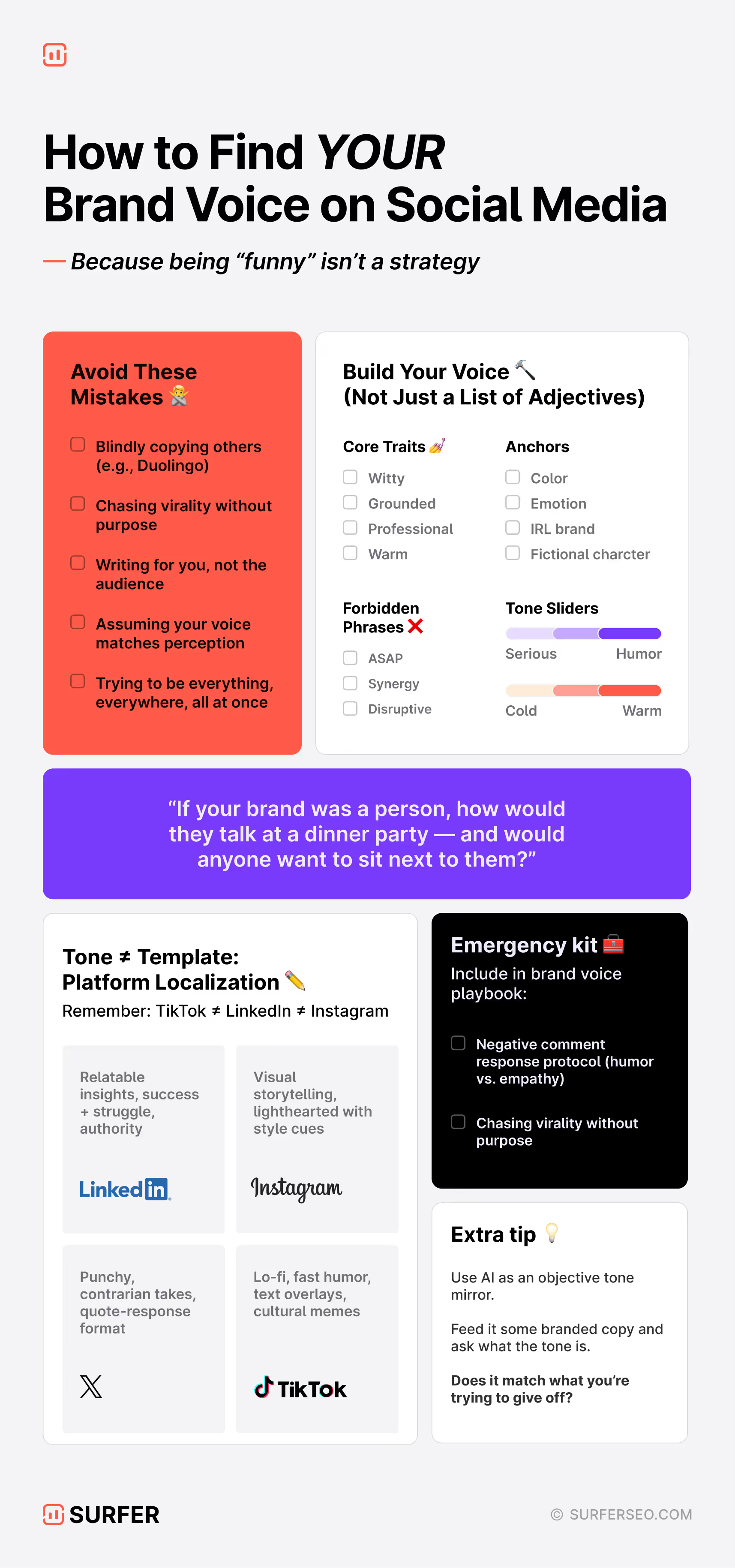Most brands misunderstand voice. They chase trends, emulate competitors, and confuse “quirky” with “effective.” The result? Inconsistent messaging, forgettable content, and zero strategic impact.
Eek.
A specific brand with a well-defined brand voice stands out both in brand marketing and brand management, helping to build brand equity and differentiate itself in a crowded, over-saturated marketplace.
Brand voice isn’t about personality for personality’s sake.
It’s about precision — communicating in a way that builds trust, drives conversion, and creates lasting relevance across platforms.
Your brand promise should be clearly reflected in your brand voice, ensuring that customer expectations align with the actual experience.
If your voice doesn’t serve a business function, it’s not doing its job. The brand name is a key element that should align with your overall voice and messaging.
The first mistake most brands make
Let’s start here: your brand is not Duolingo. Trying to replicate their viral tone — or any other standout brand — is not a strategy.
It’s a shortcut.
And most of the time, it fails. Copying your favorite brand might seem tempting, but it won’t help you develop your own brand voice that truly resonates with your audience. Duolingo’s success lies mostly in their process, not the output.
Humor without permission is noise. Trend-jumping without alignment is confusion. The question isn’t, “Can we go viral?” It’s “Does this sound like us — and is it what our audience needs?”
Here’s a better framework:
If your brand were a person at a dinner party, would anyone want to sit next to them — and what would they remember afterward?
If you can’t answer that, your voice lacks definition. Focus on building a unique brand voice that sets you apart, rather than imitating others.
Defining your brand voice
Defining your brand voice isn’t just a creative exercise—it’s the backbone of a strong brand identity.
Start by getting crystal clear on your company’s mission, core values, and the personality traits that set you apart from other brands.
Ask: What does your brand stand for?
How do you want your target audience to feel when they encounter your brand’s message?
Next, translate those answers into a distinct personality and tone.
Are you authoritative or approachable? Playful or pragmatic?
Use a brand voice template to document these choices—think of it as your playbook for every communication channel, from social media posts to email campaigns. This template should outline your preferred language, tone, and messaging dos and don’ts, ensuring that every piece of content is on brand.
Remember, your brand voice should always be tailored to your target audience and reflect your company values.
When done right, it becomes a key component of your brand’s identity, helping you build brand recognition and trust with every interaction. A strong brand voice isn’t just heard—it’s remembered.
Build the foundation: voice as brand identity infrastructure
Forget aspirational fluff. Voice needs to be operational. Every team member should understand how your brand communicates and why.
At minimum, define:
- Core voice traits (e.g., analytical, optimistic, irreverent)
- Tone tolerances (Where can you push humor? When do you stay serious?)
- Response frameworks (How do you speak when something goes wrong?)
A style guide and brand guidelines are key components for ensuring consistency in your brand's communication and your brand's content across all channels. These tools help document standards and provide clear direction for maintaining a unified brand identity.
This isn’t brand cosmetics — it’s brand infrastructure. When done right, it enables scale, protects reputation, and accelerates creative decision-making.
Consistency doesn’t mean sameness
Strong voice isn’t rigid; it’s adaptive.
Your audience doesn’t behave the same on LinkedIn as they do on TikTok — and your tone shouldn’t either. But your character — your values, language style, and intent — should be unmistakable everywhere.
Maintaining a consistent voice and same tone across all communication channels is essential for brand recognition.
The social media team plays a key role in ensuring the brand's tone is recognizable by using appropriate language and brand tone in social media captions tailored to each platform.
Think of it this way: Same character, different context.
- TikTok demands immediacy, humor, and trend fluency.
- LinkedIn calls for narrative, insight, and credibility.
- Instagram favors aesthetics and emotional resonance.
Voice isn’t static. It’s situational — and the best brands understand the difference.
Why social media posts flop (and how to fix it)
When content underperforms, don’t blame the algorithm. Diagnose the fundamentals:
- Was the message clear?
- Did it align with platform expectations?
- Was the timing strategic?
- Is your audience fatigued?
To improve results, ensure you effectively communicate your brand message and that your brand messaging is clear and aligned with the brand's message.
Refinement, not reinvention, is what builds strong voice over time.
Test one variable at a time — format, tone, structure — and let performance guide iteration.
Refining brand communication can improve customer engagement and help customers feel more connected to your brand.
The goal isn’t perfection. It’s informed, measurable evolution.
Voice is not fluff — it’s a revenue lever (when done right)
At every stage of the customer journey, voice plays a role:
- Awareness: Voice creates recognition and familiarity.
- Consideration: It builds trust and clarifies value.
- Conversion: It eliminates doubt and compels action.
- Retention: It fosters emotional connection, consumer loyalty, and brand loyalty.
A brand voice tailored to your intended audience, target market, and buyer persona—using the right brand language—can attract new customers and potential customers, while engaging target consumers more effectively.
If your content isn’t converting, the issue may not be what you’re saying — but how you’re saying it.
Precision in tone, language, and emotional resonance moves people. That’s the function of voice.
Measuring brand voice success
A compelling brand voice isn’t just about sounding good—it’s about driving results. To know if your brand’s voice is hitting the mark, you need to measure its impact on your target audience and overall brand identity.
Start with the basics: track engagement on social media, monitor brand recall, and watch for increases in brand recognition.
Are people interacting with your content? Do they remember your brand’s personality and tone?
Use analytics tools to dig into how your brand’s content performs across different channels, and look for patterns in what resonates.
Don’t stop at numbers—ask your audience directly.
Customer surveys and feedback can reveal how your brand’s communication style is perceived and whether it aligns with your intended brand persona. Regular brand audits are also essential: review your messaging across all platforms to ensure you’re maintaining a strong, consistent brand voice.
By measuring and refining your brand’s communication strategy, you’re not just chasing metrics—you’re building a successful brand identity that earns brand trust, customer loyalty, and long-term business growth. A strong brand voice is more than a marketing asset; it’s a foundation for a powerful, successful brand.

Final takeaway
If your team is still treating brand voice as “something we should get around to,” you’re leaving equity on the table. Voice isn’t a nice-to-have — it’s a force multiplier across marketing, sales, and customer experience.
It’s essential to protect all aspects of your brand's identity—including your brand's values, brand's personality, company's voice, company's brand, and company's mission—along with visual elements like your color palette and brand names, to ensure a consistent and authentic presence.
Successful branding, whether launching a new brand, engaging in corporate branding, or managing multiple brands under the same company, requires discipline and consistency; even iconic brands like Coca-Cola or other well-branded organizations rely on these principles.
Adopting a casual tone in branded content, and following a few examples of good brand practices, can further strengthen your brand's connection with your audience.
Document it. Test it. Evolve it. Then protect it with the same discipline you apply to every other high-leverage business function.
Check out “How to Find your Voice on Social Media” featuring Katie Murphy of noticed., and Surfer’s Danni Roseman.




